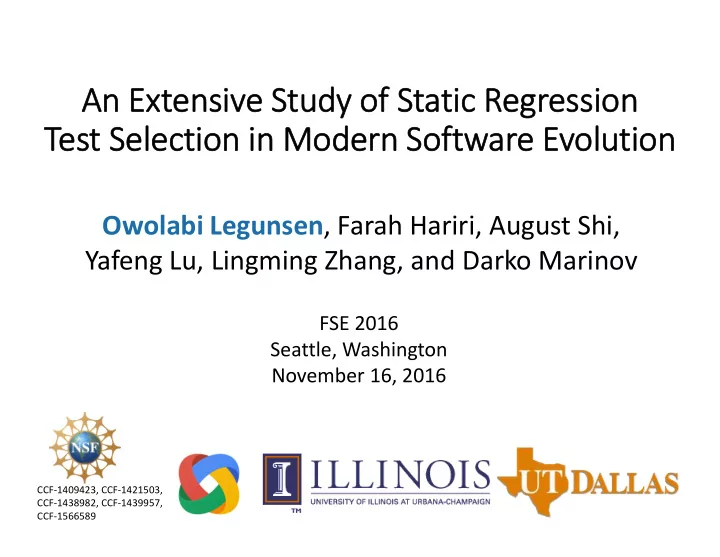

An Extensive Study of Static Regression Test Selection in Modern Software Evolution Owolabi Legunsen , Farah Hariri, August Shi, Yafeng Lu, Lingming Zhang, and Darko Marinov FSE 2016 Seattle, Washington November 16, 2016 CCF-1409423, CCF-1421503, CCF-1438982, CCF-1439957, CCF-1566589
Regression Testing • Rerun tests to ensure that code changes did not break existing functionality A T1 T1 B T2 T2 C C T3 T3 D T4 T4 E F • Problem: Regression testing can be very slow! (many tests) 2
Regression Test Selection (RTS) • Speed up regression testing by rerunning only tests that are affected by code changes A A T1 T1 B B T2 T2 C C T3 D Finding dependencies can be done statically or dynamically E T4 F • This paper: we studied static RTS approaches and compared with state-of-the-art dynamic RTS 3
Motivation for our Study • Dynamic RTS has been getting adopted recently • Dynamic RTS may not always be applicable • Instrumentation costs can be high • Dependencies may be incomplete, e.g., due to non-determinism • Static RTS was proposed previously but not evaluated at scale on modern software 4
How RTS works Find Code + Tests Dependencies Dependencies Analyze Changes Affected Tests Dependencies • An affected test can behave differently due to code changes • A test is affected if any of its dependencies changed 5
Finding and Analyzing Dependencies • Dependencies: entities that can affect test behavior A 1. Finding Dependencies: • T1 depends on A, B, C , D, T1 T1 B • T2 depends on B, C , T2 T2 C C • T3 depends on E, T3 • T4 depends on D, E, F, T4 T3 D E T4 2. Analyzing Dependencies: • T1 & T2 are affected F 6
Important RTS Considerations • End-to-end time of RTS must be less than time to run all tests Run All Tests Time Savings Find Dependencies Analyze Run Affected Tests End-to-End Time for RTS • RTS is safe if it selects to rerun all affected tests • RTS is precise if it selects to rerun only affected tests 7
RTS Techniques Evaluated • Finding dependencies can be done dynamically or statically • Dependencies can be at different levels of granularity, e.g., methods, classes, jar files, etc. • In this paper, we compare these approaches: Class-Level Dynamic Class-Level Static Method-Level Static ? ? ? End-to-End Time Safety Precision See details on method-level RTS in paper 8
Class-Level Dynamic RTS (Ekstazi [1] ) • Find Dependencies: dynamically track classes used while running each test class • Changes: classes whose .class (bytecode) files differ • Analyze Dependencies: select test classes for which any of its dependencies changed [1] M. Gligoric, L. Eloussi, and D. Marinov. Practical Regression Test Selection with Dynamic File 9 Dependencies . ISSTA 2015
Class-Level STAtic RTS (STARTS) • First, statically build a class dependency graph • Each class has an edge to direct parents and referenced classes • Find Dependencies: classes reachable from test class in the graph • Changes: computed in same way as Ekstazi • Analyze Dependencies: select test classes that reach a changed class in the graph 10
Variants of RTS Techniques • We studied 12 RTS techniques in total • 2 variants of the static/dynamic class-level RTS • Offline: pre-compute dependencies before changes are known • Online: compute dependencies after changes are known • 8 variants of static method-level RTS technique See details on method-level RTS in paper 11
Research Questions • RQ1: How do RTS techniques compare w.r.t. number of tests selected? • RQ2: How do RTS techniques compare w.r.t. end-to-end time? • RQ3: How do static RTS techniques compare with class- level dynamic RTS in terms of precision and safety? • RQ4: How do variants of method-level static RTS influence the cost/safety trade-offs? See answer to RQ4 in paper 12
Experimental Setup • 22 open-source projects from ASF and GitHub • Single-module Maven projects with JUnit4 tests • Project sizes: from 2 kLOC to 185 kLOC • 985 revisions of these 22 projects • Selection criteria: subset of latest 100 commits • Compile successfully • All tests pass • Ekstazi runs successfully 13
RQ1: Tests Selected Ekstazi selects fewer tests than STARTS 20.6% vs. 29.4% 14
RQ2: End-to-End Time 15
RQ3: Safety and Precision • Safety and precision were measured against Ekstazi • Safety violation: STARTS misses Ekstazi-selected tests: ��������������� = |� \ �| � = ����� �������� �� ������� � = ����� �������� �� ������ |� ∪ �| • Precision violation: STARTS selects tests that Ekstazi does not: ������������������ = |� \ �| |� ∪ �| 16
��������������� = |� \ �| |� ∪ �| RQ3: Safety and Precision ������������������ = |� \ �| |� ∪ �| 17
Reflection caused all Safety Violations Example simplified from Apache commons-math AbstractIntegrator STARTS misses this edge InterpolatorTest because it is not aware of reflection AbstractInterpolatorTest Integrator name = interpolatorName.replaceAll("Interpolator", "Integrator"); Class clz = (Class) Class.forName(name); i = clz.getConstructor(…).newInstance(field, field.getOne()); 18
Since this paper was accepted … • We are making STARTS safer with respect to reflection • We are evaluating STARTS on larger software systems • We have improved the STARTS tool to • handle multi-module Maven projects • find dependencies from bytecode much faster 19
Conclusions • We performed the first, large-scale empirical study of static RTS and its comparison with dynamic RTS • At the class level, we found static RTS (STARTS) comparable with state-of-the-art dynamic RTS (Ekstazi) • Similar end-to-end times • STARTS had very few safety violations • Method-level static RTS requires more work to be usable legunse2@illinois.edu 20
Recommend
More recommend